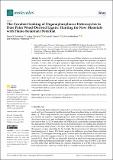Files in this item
Covalent linking of organophosphorus heterocycles to date palm wood-derived lignin : hunting for new materials with flame retardant potential
Item metadata
| dc.contributor.author | Davidson, Daniel James | |
| dc.contributor.author | McKay, Aidan | |
| dc.contributor.author | Cordes, David Bradford | |
| dc.contributor.author | Woollins, J Derek | |
| dc.contributor.author | Westwood, Nicholas James | |
| dc.date.accessioned | 2023-12-01T15:30:08Z | |
| dc.date.available | 2023-12-01T15:30:08Z | |
| dc.date.issued | 2023-12-01 | |
| dc.identifier | 296815963 | |
| dc.identifier | dc1f7aee-e242-492e-9cd6-6aa154ba8fec | |
| dc.identifier | 85179363472 | |
| dc.identifier.citation | Davidson , D J , McKay , A , Cordes , D B , Woollins , J D & Westwood , N J 2023 , ' Covalent linking of organophosphorus heterocycles to date palm wood-derived lignin : hunting for new materials with flame retardant potential ' , Molecules , vol. 28 , no. 23 , 7885 . https://doi.org/10.3390/molecules28237885 | en |
| dc.identifier.issn | 1420-3049 | |
| dc.identifier.other | ORCID: /0000-0003-0630-0138/work/147966755 | |
| dc.identifier.other | ORCID: /0000-0002-5366-9168/work/147967114 | |
| dc.identifier.uri | https://hdl.handle.net/10023/28809 | |
| dc.description | Funding: Funding: This research was funded by EaSI-CAT at the University of St Andrews (Ph.D. studentship to D.J.D.). | en |
| dc.description.abstract | Environmentally acceptable and renewably sourced flame retardants are in demand. Recent studies have shown that the incorporation of the biopolymer lignin into a polymer can improve its ability to form a char layer upon heating to a high temperature. Char layer formation is a central component of flame-retardant activity. The covalent modification of lignin is an established technique that is being applied to the development of potential flame retardants. In this study, four novel modified lignins were prepared, and their char-forming abilities were assessed using thermogravimetric analysis. The lignin was obtained from date palm wood using a butanosolv pretreatment. The removal of the majority of the ester groups from this heavily acylated lignin was achieved via alkaline hydrolysis. The subsequent modification of the lignin involved the incorporation of an azide functional group and copper-catalysed azide–alkyne cycloaddition reactions. These reactions enabled novel organophosphorus heterocycles to be linked to the lignin. Our preliminary results suggest that the modified lignins had improved char-forming activity compared to the controls. 31P and HSQC NMR and small-molecule X-ray crystallography were used to analyse the prepared compounds and lignins. | |
| dc.format.extent | 15 | |
| dc.format.extent | 3517700 | |
| dc.language.iso | eng | |
| dc.relation.ispartof | Molecules | en |
| dc.subject | Organophosphorus | en |
| dc.subject | Heterocycle | en |
| dc.subject | Lignin | en |
| dc.subject | Biomass pretreatment | en |
| dc.subject | Deacylation | en |
| dc.subject | Click reaction | en |
| dc.subject | Flame retardant | en |
| dc.subject | X-ray crystallography | en |
| dc.subject | NMR analysis | en |
| dc.subject | QD Chemistry | en |
| dc.subject | DAS | en |
| dc.subject.lcc | QD | en |
| dc.title | Covalent linking of organophosphorus heterocycles to date palm wood-derived lignin : hunting for new materials with flame retardant potential | en |
| dc.type | Journal article | en |
| dc.contributor.institution | University of St Andrews. School of Chemistry | en |
| dc.contributor.institution | University of St Andrews. EaSTCHEM | en |
| dc.contributor.institution | University of St Andrews. Biomedical Sciences Research Complex | en |
| dc.identifier.doi | 10.3390/molecules28237885 | |
| dc.description.status | Peer reviewed | en |
This item appears in the following Collection(s)
Items in the St Andrews Research Repository are protected by copyright, with all rights reserved, unless otherwise indicated.

